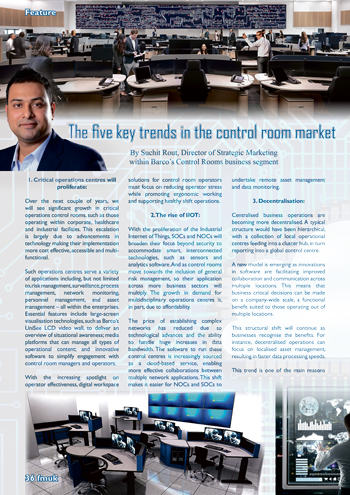The five key trends in the control room market
 By Suchit Rout, Director of Strategic Marketing within Barco’s Control Rooms business segment.
By Suchit Rout, Director of Strategic Marketing within Barco’s Control Rooms business segment.
1. Critical operations centres will proliferate
Over the next couple of years, we will see significant growth in critical operations control rooms, such as those operating within corporate, healthcare and industrial facilities. This escalation is largely due to advancements in technology making their implementation more cost effective, accessible and multi-functional. Such operations centres serve a variety of applications including, but not limited to, risk management, surveillance, process management, network monitoring, personnel management, and asset management – all within the enterprises. Essential features include large-screen visualisation technologies, such as Barco’s UniSee LCD video wall, to deliver an overview of situational awareness; media platforms that can manage all types of operational content; and innovative software to simplify engagement with control room managers and operators. With the increasing spotlight on operator effectiveness, digital workspace solutions for control room operators must focus on reducing operator stress while promoting ergonomic working and supporting healthy shift operations.
2. The rise of IIOT
With the proliferation of the Industrial Internet of Things, SOCs and NOCs will broaden their focus beyond security to accommodate smart, interconnected technologies, such as sensors and analytics software. And as control rooms move towards the inclusion of general risk management, so their application across more business sectors will multiply. The growth in demand for multidisciplinary operations centres is, in part, due to affordability. The price of establishing complex networks has reduced due to technological advances and the ability to handle huge increases in data bandwidth. The software to run these control centres is increasingly sourced as a cloud-based service, enabling more effective collaborations between multiple network applications. This shift makes it easier for NOCs and SOCs to undertake remote asset management and data monitoring.
3. Decentralisation
Centralised business operations are becoming more decentralised. A typical structure would have been hierarchical, with a collection of local operational centres feeding into a cluster hub, in turn reporting into a global control centre. A new model is emerging as innovations in software are facilitating improved collaboration and communication across multiple locations. This means that business critical decisions can be made on a company-wide scale, a functional benefit suited to those operating out of multiple locations. This structural shift will continue as businesses recognise the benefits. For instance, decentralised operations can focus on localised asset management, resulting in faster data processing speeds.
This trend is one of the main reasons Barco has been investing in solutions that enable greater decentralisation of control room functionality, giving autonomy to operators. Our OpSpace solution was designed specifically with this in mind, providing the first single digital workspace for operators to be able to securely view and control all applications with just one mouse and keyboard, increasing operator efficiency and reducing workplace stress. We’ll no doubt see greater investment in solutions like this as control room operators continue to become empowered.
There are some sectors, such as oil & gas, that are bucking the decentralisation trend. This is because it is logistically challenging and costly to build control centres at extraction sites offshore or in remote locations. So, control room management software must incorporate enterprise-grade, collaboration-ready features to maintain flexible workflows that can support remote working and remote situational management.
4. Software comes to the fore:
Display technology and visualisation tools continue to play an important role in data management which is why UniSee has proved so successful in the control room market. But it is the workflow software that crunches data in the background that is key to managing ever-increasing flows of data. Automated machines now have the capacity to run processes and dataflow systems and, over the next few years, we may see the incorporation of artificial intelligence that is able to learn and implement risk reduction protocols, significantly reducing the level of human intervention.
These automated processes manage by escalation. They oversee and analyse dataflows and alert operators if irregularities are identified by sounding an alarm. This reduces the need for continuous monitoring of dataflows by personnel as the software autonomously analyses vast amounts of data, identifies potential issues and recommends de-escalation protocols. All actions are then authorised by human intervention.
At present software is programmed to react to situations via protocols and workflows inputted by programmers. In the future, applied machine learning will be used to enable software to learn through experience and resolution which workflows should be implemented to address issues before they reach critical levels. A system where machines learn by experience will increase positive outcomes as it has the computing power to analyse vast amounts of harvested data, past and present.
5. Closer to open ecosystems:
Technology manufacturers and control room service providers are moving towards developing solutions that work in tandem with each other. There is a growth in competitor collaboration to deliver open source offerings to customers. At Barco, with the support of alliance partners, we have developed open platforms able to integrate with external systems. They work together to exchange data, visuals and analytical information. As system and network demands become ever more complex, seamless integration between software solutions will become a necessity to deliver better services and improved performance for control room operators across all sectors.
 t
t
























































